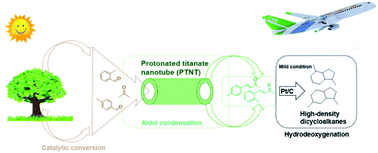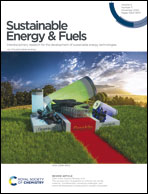Synthesis of jet fuel range high-density dicycloalkanes with methyl benzaldehyde and acetone†
Abstract
In this work, jet fuel range high-density dicycloalkanes were manufactured from methyl benzaldehyde and acetone, two platform compounds which may be obtained from lignocellulose. Protonated titanate nanotubes (PTNTs), a cheap and easily prepared solid acid catalyst, was first found to be a stable, durable and highly efficient catalyst for the preparation of the jet fuel precursors by the acid-catalyzed aldol condensation of acetone and methyl benzaldehydes. Over this catalyst, high yield (∼76%) of jet fuel precursors was reached under mild reaction conditions. The PTNT catalyst can be repeatedly used without significant deactivation, which is advantageous in real application. On the basis of the characterization, the good performance of the PTNT catalyst can be attributed to its special nanotube morphology, bigger surface area, higher acid site amount and acid strength. After the hydrodeoxygenation of jet fuel precursors in cyclohexane under mild conditions (403 K, 5 MPa, 2 h), high yields (∼90%) of dicycloalkanes were achieved. These dicycloalkanes have higher densities than ordinary jet fuel. Therefore, they may be blended into jet fuel to raise the range (or payload) of airplanes.



 Please wait while we load your content...
Please wait while we load your content...